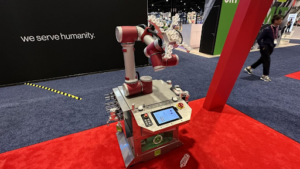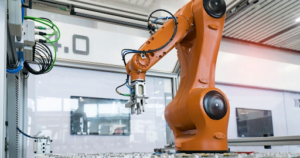The technology in our world is changing year after year. From the days before the internet to now, where information is just a click away, our world has transformed.
We see this technology everywhere. In Stop & Shop, Marty the Robot scoots around, reporting spills or potential hazards. In Whole Foods, Amazon Prime members can “Pay with Palm,” where the scan of your palm at the entrance of the store allows an automatic charge to your account.
Technology continues to advance, with automation becoming significantly more present – how far will this go?
To meet the growing demand for products, new methods of supply have been implemented. At HESCO, we’ve been assisting customers with automating factories for 80+ years, so if it’s it time for your facility to invest in smart manufacturing solutions like cobots or robots, we’ve got the answers to your questions
To understand the importance of these smart manufacturing solutions and to determine which might be a better fit for your facility, you need to know what differentiates them.
What is a Cobot?
A cobot, short for a collaborative robot, is a robotic arm that works alongside a human being or independently of a human being. Cobots are made to complete repetitive, simple, and time-consuming tasks so your workers are able to focus their time on more complex tasks.
Cobots take away the busy work and do not pose a threat to humans in your facility, as they are able to detect human interaction. If your cobot collides with an employee, it will safely come to a stop in operation.

Source: David Hughes, HESCO
Typical Use: An example of a cobot in a factory is when products are placed on a pallet to be shipped out. The cobot can move finished products onto the pallet and get them ready. With the persistence of the cobot, there is no stopping for breaks, as a human may do.
What is a Robot?
A robot, also known as an industrial robot in manufacturing, is an arm that is heavy-duty and used to automate intensive production tasks. Such robots are created to completely take the place of human jobs. The assembly line is usually built around the robot rather than the other way around.
Since a robot is the central point of an assembly line, they must be programmed properly to maintain consistency of completing tasks.

Source: Built-In
Typical Use: An example of a robot in a factory is when welding is needed. Robotic welding can be done with precision and consistency, speeding up the assembly line. With consistent precision, the robots can get products down the line quicker than a human could.
Cobots vs. Robots
Now that we’ve covered the basics of two smart manufacturing solutions, we want to dive deeper into key features that can help you determine which could be a better solution for you.
Programming
With every robotic product you buy, you must program it so it can do exactly what is needed in your facility. Everyone who purchases a robotic feature for their facility is likely purchasing for different reasons — hence why they must be programmed.
Because of their simplicity in the facility, cobots are fairly easy to program. Being a smaller-scale robot, they are able to be physically guided through the programming.
Additionally, since the tasks that cobots will complete are less complex, the programming is way simpler.
As expected, a robot is much more complicated to program. The complexity of the tasks that are being completed by the robots creates a longer programming process, where more intricacies are involved.
If you were to program a robot into your facility, instead of guiding it like the cobot, you would have to code the maneuvers you’d like it to complete using coding language.
The ease of programming with the cobot can create a better user experience for you, while programming of the robot can become a roadblock — but you can contact a System Integrator (link article if published before) to help you out.
Human Interaction
Unless your facility is going to be fully automated — meaning no humans work there at all — then you are going to need to know what level of human interaction you want this robotic arm to have with your employees.
Cobots are collaborative (literally — it’s in the name!) with humans. Therefore, there is a higher level of human interaction. Cobots are implemented into the assembly line, taking the place of a repetitive task that is not appealing to employees anymore. Most of the time, these jobs that include these tasks are positions that have been open for months because of the lack of appealment.
Robots, on the other hand, are not too keen on human interaction. They are here to replace humans, not work alongside them.
They can complete more in-depth tasks that take an enormous heavy lifting off your employees.
So, even though they are not “human interaction friendly,” they are extremely skilled and can ultimately take the place of an employee.
Guarding Applications
Let’s say you have a welding position open in your facility. The position has been open for almost a year, slowing down production because one of your employees has taken on two positions. Instead of wasting time recruiting, you decided to purchase a robot.
One aspect that is talked about in the purchasing process is safety. Since robots are big and bulky, with less sensing of humans, they could collide with an employee. This could cause an unsafe environment.
So, you decide to add on some guarding applications, which are implemented to act as a sensor so the robot does not ever collide with your employees.
Since cobots can actually interact and work alongside humans, they do not have as much guarding required. If you were to implement a cobot into your facility, you would likely not have to worry much about guarding.
But, robots require guarding in most applications. Because of the lack of human interaction that these robots have, and the likeliness of them being purchased to replace a human, the guarding has to be implemented.
If there is no guarding in a robot application, it can cause a dangerous environment for your employees to walk around in. Just like how you don’t want to have off-task employees, you do not want your robot to get off task if accidentally bumped into. It can cause a massive danger in the workplace.
Speed and Strength
The appeal of investing in a robotic product for your facility is the fact that you won’t have to worry about fatigue or complaints from employees.
Similar to the other features, because cobots work alongside humans, they act as any other employee. So, their speed and strength is that of a human. Cobots can get the job done, on time and precisely, just like any other employee in the workplace.
However, if you are having trouble meeting the demand of products, robots possess superhuman strength and speed. Double, and sometimes even more, that of a human, they can get the job done twice as fast.
Cost
Finally, the most important question on your mind: how much do these things cost?

Source: HESCO
Looking at the features at-a-glance, you can probably guess that the cobot will be significantly cheaper than the robot.
According to Man + Machines, cobots range anywhere from $10,000 to $50,000. This range is so large because of certain features and because of the size variation of the cobot. The more add-ins you purchase or choose to add to the cobot, the more expensive it becomes.
Cobots are significantly cheaper. So, how much more expensive are robots?
According to Robots Done Right, robots start at around $25,000 and can go upwards of $100,000. This investment is so large because of the complexity of the tasks that the robot can complete.
Think about it this way: you are replacing a human being, who had a salary. But, you also need to account for electricity to run the robotic arm and upkeep of the machine as well.
So, an investment you would make in a robot should equate or exceed the investment that you make in an employee (or, multiple employees) that were completing that one job.
So, Which One is the Option For You?
If you are looking for a smart manufacturing solution that replaces what a human can do and more, then a robot would be the right choice for you. This will increase your facility’s efficiency and truly hit that demand that you have been striving for.
But, if you are looking to make your employee’s jobs easier by implementing a product that can get those nuisance tasks out of the way, a cobot is the right option for you.
Either option you choose, the investment will put you on the right path to meeting the needs of your demand.
What We Think at HESCO: Cobots > Robots
Cobots are our preferred recommendation when it comes to a smart manufacturing solution. The ease of programming and its ability to not completely replace a human job, but make it easier, is something we support here at HESCO.
But, every facility is different. If you are looking to get more information and insights on how a robotic arm, cobot or robot, can help you, reach out to our team! We’d be happy to walk you through what can best suit the needs of your facility.
